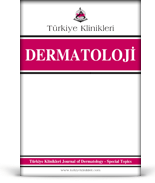Amaç: Pediatrik dermatoloji hastaları günlük pratikte sıklıkla karşılaşılan hasta grubunu oluşturmaktadır. Yapılacak anket çalışması ile Türkiye'deki deri ve zührevi hastalıkları ihtisas eğitiminin pediatrik dermatoloji eğitimi açısından yeterliliğinin değerlendirilmesi amaçlanmıştır. Gereç ve Yöntemler: Aralık 2022-Mart 2023 tarihleri arasında Türkiye genelinde görev yapan 3-4. yıl deri ve zührevi hastalıkları araştırma görevlileri, uzman doktorları ve öğretim görevlisi doktorlardan oluşan toplam 201 kişiye 55 soruluk Google anket formu (docs.google.com/forms) kullanılarak hazırlanan çevrim içi anket uygulandı. Bulgular: Çalışmamıza 56 araştırma görevlisi doktor, 107 uzman doktor, 38 öğretim görevlisi doktor olmak üzere toplam 201 kişi katılmıştır. Çalışmamıza katılanlardan 74 (%37) kişi pediatrik dermatoloji eğitimi almıştır. Yetmiş iki (%97,3) kişi pediatrik dermatoloji eğitimini eğitim aldığı klinikte alırken, 2 (%2,7) kişi eğitim aldığı klinik dışındaki bir hastanede görevlendirilerek pediatrik dermatoloji eğitimi almıştır. Pediatrik hasta yönetiminde dermatoloji asistanı, 46 (%16,9) kişi birincil olarak görevliyken, 113 (%41,5) kişi öğretim görevlisi/uzman gözetiminde görevliydi, 36 (%13,2) kişi ise pediatrik hasta yönetiminde görev almamıştı. İhtisas süresince pediatrik dermatolojiye spesifik konuların anlatılması sorusuna 116 (%58,9) kişi evet yanıtını vermiştir. Çalışmamıza katılanların ihtisas programı pediatrik dermatoloji eğitim programı memnuniyetine bakıldığında; program memnuniyetinin en yüksek olduğu grubu %44,8'lik oranla öğretim görevlisi doktorlar oluşturmaktaydı. Sonuç: Pediatrik dermatoloji eğitimi, ayrı bir yan dal olmaması nedeniyle şimdiye kadar dermatoloji eğitiminden ayrı tutulmamıştır. Ancak yeni planlamada ayrı bir yan dal olması gelişimine katkı sağlayabilir.
Anahtar Kelimeler: Pediatrik dermatoloji; infantil hastalıklar; çocukluk çağı dermatozları; uzmanlık eğitimi
Objective: Pediatric dermatology patients constitues one of the most frequently encountered patient group in daily clinical practice. The present survey-based study aimed to evaluate the proficiency of pediatric dermatology training during dermatology and venereology residency in Türkiye. Material and Methods: An online Google questionnaire form (docs.google.com/forms) consisting of 55 questions, was carried out among 201 participants who were 3rd and 4th year dermatology research assistants, specialists and academicians between December 2022 and March 2023. Results: A total number of 201 participants were included in the study. Fifty six were research assistants, 107 were specialists and 38 were academicians. Only 74 (37%) participants had received pediatric dermatology training. Seventy two (97.3%) had pediatric dermatology training in their own residency clinic, whereas 2 (2.7%) had their training in another hospital by designation. In the management of pediatric patients, 46 (16.9%) dermatology research assistants were the primary attendants, 113 (41.5%) were under the supervision of a specialist or academician whereas 36 (13.2%) did not take any place in the management of pediatric patients. One hundred sixteen (58.9%) participants declared that they had received lectures related to pediatric dermatology during their residency training. If we were to look at the pediatric dermatology training satisfaction rates, the highest rate of satisfaction was observed among academicians with a rate of 44.8%. Conclusion: There is no pediatric dermatology subspeciality in our country. However, having a separate subspeciality in the new planning may contribute to its development.
Keywords: Pediatric dermatology; infantile diseases; childhood dermatoses; specialist training
- Nijhawan RI, Mazza JM, Silverberg NB. Pediatric dermatology training survey of United States dermatology residency programs. Pediatr Dermatol. 2014;31(2):131-7. [Crossref] [PubMed]
- Yılmaz S, Akkaya VB. Dermatoloji uzmanlık eğitiminde sorunlar ve çözüm önerileri : asistan görüşlerinin değerlendirilmesi [Problems and proposals of their solutions in dermatology residency training: a survey of residents' opinions in Turkey]. Turkdem. 2009;43(1):10-5. [Link]
- Cengiz FP, Kemeriz F, Emiroǧlu N, Meydan MC. Deri ve zührevi hastalıkları uzmanlık öğrencilerinin görüşleri: uzmanlık eğitiminde sorunlar ve çözüm önerileri [Dermatology residents' opinions: problems and proposals of their solutions in residency training]. Turk Dermatoloji Derg. 2014;8(2):88-94. [Crossref]
- Özkur E, Kaynak E, Gürel MS. Where are we in cosmetics and esthetics practices in educational clinics in Turkey? Turkish J Dermatology. 2019;13(3):95-8. [Crossref]
- Beksaç B, Erbil H, Dundar O, Caliskan E. The perspective of dermatology residents on cosmetology training: a survey. J Cosmet Dermatol. 2020;19(12):3338-43. [Crossref] [PubMed]
- Akhavan A, Murphy-Chutorian B, Friedman A. Pediatric dermatology training during residency: a survey of the 2014 graduating residents. Pediatr Dermatol. 2015;32(3):327-32. [Crossref] [PubMed]
- Freiman A, Barzilai DA, Barankin B, Natsheh A, Shear NH. National appraisal of dermatology residency training: a Canadian study. Arch Dermatol. 2005;141(9):1100-4. [Crossref] [PubMed]
- Freeman SR, Greene RE, Kimball AB, Freiman A, Barzilai DA, Muller S, et al. US dermatology residents' satisfaction with training and mentoring: survey results from the 2005 and 2006 Las Vegas Dermatology Seminars. Arch Dermatol. 2008;144(7):896-900. [Crossref] [PubMed]
- Porriño-Bustamante ML, Buendía-Eisman A, Arias-Santiago S. What do dermatologists and dermatology residents think about their residency training in dermatology? Front Med (Lausanne). 2023;10:1293927. [Crossref] [PubMed] [PMC]
- Hopkins C, Jalali O, Guffey D, Dao H. A survey of dermatology residents and program directors assessing the transition to dermatology residency. Proc (Bayl Univ Med Cent). 2020;34(1):59-62. [Crossref] [PubMed] [PMC]
- Mehrabi D, Cruz PD Jr. Educational conferences in dermatology residency programs. J Am Acad Dermatol. 2006;55(3):523-4. [Crossref] [PubMed]
- Deri ve Zührevi Hastalıklar Uzmanlık Eğitimi Planı ve Uzmanlık Öğrencisi Karnesi [İnternet] [Erişim tarihi: 12.08.2024]. Erişim linki: [Link]
- Inanir I, Sahin MT, Gündüz K, Dinç G, Türel A, Oztürkcan S. Prevalence of skin conditions in primary school children in Turkey: differences based on socioeconomic factors. Pediatr Dermatol. 2002;19(4):307-11. [Crossref] [PubMed]
- Del Pozzo-Magaña BR, Lazo-Langner A, Gutiérrez-Castrellón P, Ruiz-Maldonado R. Common dermatoses in children referred to a specialized pediatric dermatology service in mexico: a comparative study between two decades. ISRN Dermatol. 2012;2012:351603. [Crossref] [PubMed] [PMC]
- Nanda A, Al-Hasawi F, Alsaleh QA. A prospective survey of pediatric dermatology clinic patients in Kuwait: an analysis of 10,000 cases. Pediatr Dermatol. 1999;16(1):6-11. [Crossref] [PubMed]







.: Process List